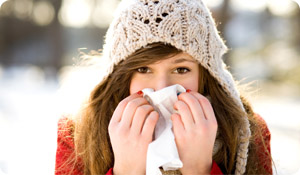
It’s one thing to have a runny nose in winter, quite another to be battling an assortment of unpleasant symptoms and contagious germs for weeks on end. Here’s what to look out for this during this cold and flu season, and what you can do to help protect yourself and your loved ones.
Cold and flu symptoms result from viral infection. These symptoms—runny nose, sore throat, difficulty breathing, and sometimes fever or upset stomach—are uncomfortable and inconvenient at best, and can even be deadly, especially for high-risk groups like very young children, the elderly, pregnant women, and anyone with a compromised immune system or certain other medical conditions. While the nature and source of viral symptoms can be difficult to pinpoint, there are some very easy steps you can take to try to avoid coming down with any of them this winter.
Flu
Although flu viruses spread around the country every winter, it is impossible to predict the strain, timing, severity, and length of the season because the viruses constantly change and new strains appear from year to year, according to the Centers for Disease Control and Prevention (CDC). Although we think of it as a winter health problem, flu viruses circulate throughout the year, so it is possible to get flu anytime. Peak flu season commonly occurs between December and February, but the entire season usually runs from October through May.
You’re probably familiar with these flu symptoms, which commonly include fever, headache, cough, sore throat, runny or stuff nose, body aches, chills, fatigue, and exhaustion. More rarely, some people have diarrhea and vomiting, though this is more common in children than adults.
With few exceptions, CDC recommends that everyone age 6 months and older get an annual flu vaccination. This is especially important for those at high risk of complications from flu. Each year, flu vaccines are developed to protect against specific viruses that medical experts believe will be most common throughout that season.
"Flu can be dangerous for anyone, and flu vaccines are the first and best way to prevent influenza infection," says Lisa Grohskopf, MD, a medical officer with CDC’s Influenza Division. "Flu vaccine can reduce flu illnesses, doctors’ visits, and missed work and school due to flu, as well as prevent flu-related hospitalizations and deaths."
Rhinovirus
Rhinovirus causes the symptoms of what most of us know as the common cold. While it is miserable, with some symptoms similar to flu, rhinovirus generally does not cause gastrointestinal problems and rarely fever or severe body aches. Instead, ear and sinus congestion, sore throat, and headache often accompany the typical symptoms of stuffy or runny nose, sneezing, and coughing. You can be infected by rhinovirus and develop cold symptoms anytime throughout the year.
Enterovirus
Enteroviruses causing respiratory difficulties and fever commonly occur throughout the year, but like the viruses that cause flus and colds, there are different strains, and some are more serious than others. This year’s particularly virulent strain—Enterovirus D68— has been sweeping across the country and causing severe respiratory problems in those who succumb. Enterovirus D68 is particularly hard on young children, especially those with asthma. It may start with symptoms of a common cold but then cause wheezing that leads to serious breathing problems. If this happens, get medical help right away.
Health officials are also reviewing rare cases of arm or leg paralysis that developed in a small number of children who came down with Enterovirus D68. Symptoms of paralysis began after respiratory symptoms resolved, and both the progression and recovery from weakness has been slow. Experts are not sure if or how paralysis is directly related to the enterovirus.
Prevention
These simple preventative methods help stop the spread of germs and can prevent you and others from picking up seasonal viruses:
- Avoid close contact with anyone who is sick and, if you’re the one who is sick, protect healthy people by keeping your distance while symptoms are active.
- To facilitate #1 above, stay home from work, school, shopping malls, and other places where people gather while your symptoms are active.
- When coughing or sneezing, cover your mouth and nose with a tissue.
- Wash your hands often with soap and water for 15 seconds. If you can’t do this, use a hand sanitizer that contains at least 60% alcohol.
- Keep your hands away from your eyes, nose and mouth. Touching these areas is a very common way for germs to enter your system.
- Adopt healthy habits, such as frequently cleaning and disinfecting surfaces at home and at work, including doorknobs and drawer handles. Drink a lot of fluids, eat nutritious foods, control stress, exercise, and get plenty of sleep.
John Lipuma, MD, reviewed this article.
Sources
Burns, Erin. CDC. E-mail messages to author.
Lipuma, John. E-mail messages to author.
"What You Should Know for the 2014-2015 Influenza Season." Centers for Disease Control and Prevention. Page last updated October 28, 2014.
"Frequently Asked Questions - Hand Hygiene." Centers for Disease Control and Prevention. Page last updated October 25, 2013.
"Keeping Hands Clean." Centers for Disease Control and Prevention. Page last updated February 1, 2011.





